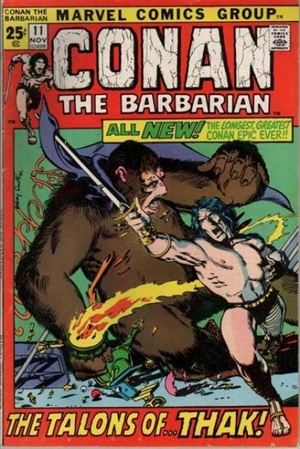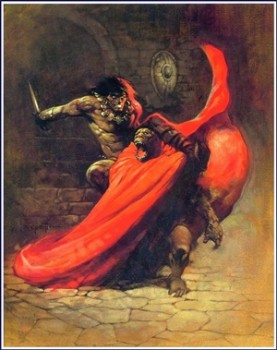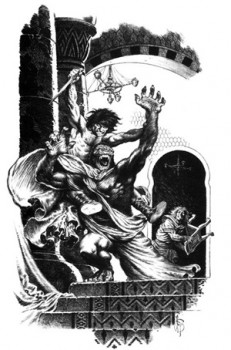Hither Came Conan: Bob Byrne on “Rogues in the House”
 When I was pitching this series to folks, I was using the title, The Best of Conan. I didn’t come up with Hither Came Conan for about eight months, I think. Yeah, I know… The idea behind the series came from an essay in my first (and so far, only) Nero Wolfe Newsletter. The plan for 3 Good Reasons is to look at a story and list three reasons why it’s the ‘best’ Wolfe story. And I toss in one ‘bad’ reason why it’s not. And finish it off with some quotes. You’ll be reading more 3 Good Reasons here at Black Gate in 2020.
When I was pitching this series to folks, I was using the title, The Best of Conan. I didn’t come up with Hither Came Conan for about eight months, I think. Yeah, I know… The idea behind the series came from an essay in my first (and so far, only) Nero Wolfe Newsletter. The plan for 3 Good Reasons is to look at a story and list three reasons why it’s the ‘best’ Wolfe story. And I toss in one ‘bad’ reason why it’s not. And finish it off with some quotes. You’ll be reading more 3 Good Reasons here at Black Gate in 2020.
So, I’m going to take a somewhat different tack from those who have come before me (I doubt I could have measured up, anyways) and pick out two elements that make this story one of Howard’s best recountings of the mighty-thewed Cimmerian. Then, throw a curveball from the Wolfe approach and highlight a few items worthy of note.
OUR STORY
Obviously, you need to read this story, but here’s a Cliff’s Notes version: Nabonidus, the Red Priest, is the real power in this unnamed Corinthian city. He gives a golden cask to Murilo, a young aristocrat. And inside the cask is a human ear (remind you of Sherlock Holmes? It should.). We learn a little later on that Murillo has been selling state secrets, and the ear is from a clerk he had dealings with. The jig is up!
Given the choice of running away, waiting meekly for assured death, or finding a tool to escape his predicament, he chooses the latter. And Conan is that tool. Wait: that didn’t sound right…
Conan and a Gunderman deserter had been successful thieves until a fence, a Priest of Anu, betrayed them. The priest also happened to be a spy for the police. As a result, the unnamed Gunderman (more on that below) was captured and hung. Conan then cut off the priest’s head in revenge. A ‘faithless woman’ (presumably his current main squeeze) betrayed him to the police, who captured the Cimmerian as he hid out, drunk.
Murillo visits the cell and Conan agrees to kill Nabonidus in exchange for his freedom. Things go a bit awry and Murillo goes after Nabonidus himself but faints at the sight of the red priest in his house. Meanwhile, Conan, after casually killing his ex-girlfriend’s new lover and then dumping her in a cesspool, sneaks into the pits under Nabonidus’ house, where he encounters Murillo, who had been dumped down there.
Creeping along in the dark, they come across the unconscious Nabonidus. Thak, the priest’s semi-human ape-man ‘pet’ has revolted and taken Nabonidus’ place, killing the man’s guard dog and servant, and donning his red cape. It was the sight of him that caused Murillo to faint.
Thak aspires to humanhood and is emulating Nabonidus. The three men form an unlikely alliance against the usurper. Conan (with a little help from Murillo) kills Thak in a titanic struggle. Nabonidus then tries to slay the other two men, but while he’s giving the standard villain speech, Conan kills him with a chair.
Yeah. You read that right. A chair.
So, what are a couple elements that really stand out in this tale?
CIVILIZATION VS BARBARISM
 Perhaps the most common theme found in Robert E. Howard’s writings (as well as prevalent in his voluminous letters), is that of barbarism vs. civilization. Whether discussing the (to him) inevitable decline of civilization; or the false patina of honor and integrity ‘civilized men’ cloak themselves in when double-dealing with their perceived inferiors – which always includes a certain Cimmerian; or cultures battling savages (often the Picts); there are opposing forces at work.
Perhaps the most common theme found in Robert E. Howard’s writings (as well as prevalent in his voluminous letters), is that of barbarism vs. civilization. Whether discussing the (to him) inevitable decline of civilization; or the false patina of honor and integrity ‘civilized men’ cloak themselves in when double-dealing with their perceived inferiors – which always includes a certain Cimmerian; or cultures battling savages (often the Picts); there are opposing forces at work.
It could be viewed as the continual struggle between the progression, or regression of culture,
The ‘lost cities/civilizations’ stories resonate with this theme.
The title city of “Xuthal of the Dusk” is the poster child for this decline. The inhabitants are morally degenerate, sexually obsessed and completely decadent. Xuthal represents the inevitable decay of civilization; with Conan showing the vitality and life of the barbarian.
His final Conan story, “Red Nails,” which Keith J. Taylor wrote about a few weeks ago, seemed to take the idea to its final conclusion. The elimination of a civilization that has fallen into decline and is willfully annihilating itself.
“Beyond the Black River” looks at the conflict at a poly-societal level. It pits the ‘savage Picts’ vs. the civilized settlers along the frontier. The Picts are pushing back against the intruding settlers. Balthus is a woodsman, while Conan is a barbarian from the northlands. The Picts, of course, are primal savages. Balthus dies, Conan survives, and the Picts reclaim their lost province, pushing the settlers back across the Thunder River. At the end of the story, an unnamed settler delivers one of the most famous lines in the entire Conan Canon:
“Barbarism is the natural state of mankind. Civilization is unnatural. It is a whim of circumstance. And barbarism must always ultimately triumph.”
But in “Rogues in the House,” the issue is tackled on a micro level (which is also the case in “The God in the Bowl,” which Mark Finn wrote about last week). It’s not about self-decaying, morally bankrupt, decadent cultures: Civilization versus barbarism is viewed through individuals.
We saw a bit of this in “The Scarlet Citadel,” when Conan berates the kings who have arranged his capture and declared him a barbarian, unfit to be a king. It’s one of my favorite bits of Howard writing in the entire Conan Canon.
In “Rogues,” the civilized priest, Nabonidus, is at the extreme ‘evolved’ end of the spectrum. He is a powerful man, product of modern culture. He is the supreme power in the city and is feared by all.
The primitive Thak, while developed for his kind, is at the other, ‘unevolved’ end of the spectrum. He was brought out of the wild. Nabonidus tries to humanize him. Too successfully, as we see.
Conan, a primitive from Cimmeria, is somewhere in between, taking on a veneer of civilization over his barbarian self through is wanderings, like a cape over his bare shoulders.
That’s our working scale. And Howard uses it to show us that Conan, the barbarian, is more civilized than the cultured Red Priest. I suspect that I’ll do a Black Gate post solely on this topic, somewhere down the line.
CHARACTERIZATION
 I think that, in Howard’s best Conan’s adventures, the characters are well-developed within the constraints of a short story. Young Conan is at the end of his career as a thief, and he is more mature, and wiser, than the stranger to civilization we met in “The God in the Bowl” and “The Tower of the Elephant.”
I think that, in Howard’s best Conan’s adventures, the characters are well-developed within the constraints of a short story. Young Conan is at the end of his career as a thief, and he is more mature, and wiser, than the stranger to civilization we met in “The God in the Bowl” and “The Tower of the Elephant.”
“But Murilo, for all his scented black curls and foppish apparel, was no weakling to bend his neck to the knife without a struggle.”
He arranges for Conan to escape from prison, if he’ll then kill Nabonidus for Murilo. And even still, when he learns that the jailer he bribed to free Conan has been arrested, he buckles on a sword and goes to try and kill Nabonidus himself. Conan is on the verge of losing his battle with Thak when Murilo smashes a chair on the beast’s back. It distracts him just enough for the Cimmerian to put his blade into Thak’s heart, killing him.
Nabonidus, the Red Priest, is used to running the city. He gets what he wants. He has unchecked power.
He is cruelly arrogant. Full of his own power, he sends the ear in a box to Murillo, rather than simply having him captured, or executed, or whatever. He wants to terrorize the aristocrat. To be fair, he does just that.
But he finds himself unconscious, in his own pits. Forced to work with a man he has basically put a hit out on; and a simple barbarian. Nabonidus has been deposed by his own creation, as it were. Yet, he takes pride that Thak emulates hm and springs a death trap on some intruders. Nabonidus is true to himself.
Of course, once the danger is passed, he becomes the evil ruler and betrays his recent comrades. And talk about arrogant. Howard doesn’t just describe, he shows. Nabonidus need only pull a rope, hanging right next to him, and Conan and Murilo are dead. But nooooo, he taunts them. He brags. He explains his thinking. And Conan throws a chair at him, smashing his skull and killing him. So ends the Red Priest.
I always felt like underlying that chair finale was Conan yelling, “Just shut the hell up!”
I also enjoyed the rebels that break into Nabonidus’ house after Thak has taken over. Though, these folks, rightly or wrongly, bring to mind the People’s Front of Judea (Monty Python’s The Life of Brian).
AND WORTHY OF NOTE
MURILO & STATE SECRETS
Murilo is a young nobleman. At a court festival, he receives a box from Nabonidus. It contains a severed ear. And he knows the head which that ear used to be attached to. It was taken from a court secretary, who was selling state secrets to Murilo, who in turn was selling them to rival powers.
Conan, Murilo, and Nabonidus end up trapped in the pits below the Red Priest’s house. Nabonidus challenges Murilo with his crimes, and the nobleman essentially replies, “Oh yeah? Well, you’re worse!” And adds, “This Cimmerian is the most honest man of the three of us, because he steals and murders openly.”
Dark Horse made Murilo a sympathetic traitor. In their version of “Rogues in the House,” he is a prince, and stepson of the king. The kingdom was full of corruption and unrest. Murilo wanted to make “the empire whole again.” So, he was really a rebel, working to bring down a corrupt regime. While this certainly works, it’s not even implied in Howard’s story.
Nabonidus’ ‘gift’ of the box, which opens the story, is shades of Sir Arthur Conan Doyle’s, “The Cardboard Box.” Miss Susan Cushing receives two human ears in a box in the mail. It was actually meant for her sister, Sarah. Sarah was one of those meddlesome, annoying types – reminds me of the ‘aunt’ in a Jane Austen novel. Sarah had caused trouble in her sister Mary’s marriage to Jim Browner and helped facilitate her sister’s affair. Browner ended up killing Mary and her lover, cutting off an ear from each, and mailing them to the Cushing house.
Howard was a Doyle fan, and Patrice Louinet has identified elements of Doyle’s historical, The White Company, in Howard’s work.
TREATMENT OF EX-GIRLFRIEND
Conan’s girlfriend (I think ‘ex’ is a fair term here) ratted him out to the authorities, resulting in his imprisonment and, presumably, eventual execution (he not only robbed the Priest of Any, he went back later and cut off his head). Conan, out of prison thanks to Murilo’s help, decides to chat with her about her actions.
He sees her new boyfriend coming out of her room and kills him instantly. He confronts her, picks her up, carries her outside and throws her in a cesspit. Then heads off to assassinate a priest. People have complained about Conan’s actions towards the girl. Let’s look at this for a moment:
- Robs a priest;
- Goes back and beheads said priest;
- Kills his ex-girlfriend’s lover without a moment’s hesitation or even giving him a chance;
- Throws his ex-girlfriend (who got him arrested and his partner executed) into a cesspit;
- Attempts to assassinate another priest as payment for getting him out of prison.
I don’t think number 4 is really the major problem with Conan’s actions in this story!
THE EAR
Some of you may know that I’m a Sherlock Holmes buff. Which is why my first column here at Black Gate, which ran for thee years, was called The Public Life of Sherlock Holmes (little take on Vincent Starrett, there). Howard was a fan of Arthur Conan Doyle and may well have read the Holmes tale, “The Adventure of the Cardboard Box.” Mis Susan Cushing receives in the mail, a box which contains two mismatched human ears. Holmes deduces that they belong to her sister, Mary, and Mary’s lover. The two had been killed by Mary’s estranged husband, Jim. Jim actually meant to send the ears to a third sister, Sarah, but that’s neither here nor there (then where the heck is it?).
In the Holmes tale, the ‘ear in a box’ isn’t a warning. But it absolutely is a message. An important one. Howard might have gotten the idea of Nabonidus giving Murillo the surprise package from that Holmes story.
HALL OF THE DEAD
Howard wrote a synopsis of a story which L. Sprague de Camp completed as “Halls of the Dead.” The Gunderman officer who is after Conan but becomes his reluctant ally, is named Nestor (in both the synopsis and the story). I think that the de Camp did a good job and I quite like the story.
Dark Horse adapted the story, retaining Nestor and fleshing out his parts. In fact, he is Conan’s companion in the robbery of the Priest of Anu. And he’s the one who is hung at the beginning of “Rogues in the House.”
Roy Thomas, in adapting the storyline for Marvel’s Conan the Barbarian comic, changed Nestor’s name to ‘Burgun,’ “for no particular reason.” Issue 8, The Keepers of the Crypt, tells the story of “Hall of the Dead.”
Issue 10, The Wrath of Anu, tells the story of Conan and Burgun (Nestor) robbing the priest of Anu, then of Burgun’s capture and hanging. Conan’s girlfriend does not betray him in this version.
Issue 11, the longest in the series until issue 100, spent 34 pages telling “Rogues in the House.” Add in numbers 8 and 10 and it was about 79 pages around “Rogues.”
IN A LETTER TO CLARK ASHTON SMITH
“Glad you like Rogues in the House. That was one of those yarns which seemed to write itself. I didn’t rewrite it even once. As I remember I only erased and changed one word in it, and then sent it in just as it was written. I had a splitting sick headache, too, when I wrote the first half, but that didn’t’ seem to affect my work any. I wish to thunder I could write with equal ease all the time. Ordinarily I revise even my Conan yarns once or twice, and other stuff I hammer out by main strength.”
Prior posts in the series:
Here Comes Conan!
The Best Conan Story Written by REH Was…?
Bobby Derie on “The Phoenix in the Sword”
Fletcher Vredenburgh on “The Frost Giant’s Daughter”
Ruminations on “The Phoenix on the Sword”
Jason M Waltz on “The Tower of the Elephant”
John C. Hocking on “The Scarlet Citadel”
Morgan Holmes on “Iron Shadows in the Moon”
David C. Smith on “The Pool of the Black One”
Dave Hardy on “The Vale of Lost Women”
Bob Byrne on Dark Horse’s “Iron Shadows in the Moon”
Jason Durall on “Xuthal of the Dusk”
Scott Oden on “The Devil in Iron”
James McGlothlin on “The Servants of Bit-Yakin”
Fred Adams on “The Black Stranger”
Stephen H. Silver on “Man Eaters of Zamboula”
Keith J. Taylor on “Red Nails”
Ryan Harvey on “Hour of the Dragon”
The Animated Red Nails Movie that Never Happened
Mark Finn on “The God in the Bowl”
 Bob Byrne’s ‘A (Black) Gat in the Hand’ was a regular Monday morning hardboiled pulp column from May through December, 2018.
Bob Byrne’s ‘A (Black) Gat in the Hand’ was a regular Monday morning hardboiled pulp column from May through December, 2018.
His ‘The Public Life of Sherlock Holmes’ column ran every Monday morning at Black Gate from March, 2014 through March, 2017 (still making an occasional return appearance!).
He also organized Black Gate’s award-nominated ‘Discovering Robert E. Howard’ series.
He is a member of the Praed Street Irregulars, founded www.SolarPons.com (the only website dedicated to the ‘Sherlock Holmes of Praed Street’) and blogs about Holmes and other mystery matters at Almost Holmes.
He has contributed stories to The MX Book of New Sherlock Holmes Stories – Parts III, IV, V and VI.
And he is in a new anthology of new Solar Pons stories, out now.
YES! This is the kind of article I want to read in this series! You’ve definitely done your homework, Bob, and made some of the other entries, even though competently done, feel phoned in.
I could quibble about you calling Thak “Zak” at one point, but … oh wait. Just did. My bad.
I’m a little astonished you could get through the piece without mentioning Frank Frazetta’s iconic cover take on the tale (which you do, at least, reproduce). But perhaps I shouldn’t be. This is, after all, about the STORY, and the Frazetta painting is very much a Johnny-come-lately, even if it’s the one thing that makes this story so memorable for most of us. (The Lancer CONAN was one of the first Conan books I bought, back in the day–and it was definitely on the strength of that cover.)
I really like the way you put everything in context, from the Holmes angle, to the barbarism vs. civilization theme, to the Nestor connection, to the acute debunking of the familiar complaint about Conan’s treatment of his ex.
And as an obstinent de Camp fan (admittedly not always in regard to his Conan work), I appreciated the charitable nod to that worthy.
Not sure I’d rate “Rogues” among the top Conan tales, but it’s definitely a cut above the stories from his “write for the Brundage cover” period. Your examination of the story is, however, certainly one of the best in this series.
Thanks, Brian Glad you liked it!
Oops – ‘Zak’ is gone.
The cover of Modiphius’ ‘Conan the Thief’ RPG book is a very cool recreation of the Frazetta painting. I think it’s two panels wide on the inside cover (don’t have mine handy). It’s great. I really like a lot of the Modiphius art.
One of the things I, personally, have gotten out of this series, is that there are some rather un-enviable actions by Conan. Granted, they’re colored by my faith, but it’s still MY perception.
in this story, I only seem to hear people talk about the cesspool dump – if that. That didn’t strike me as the big issue.
I’m more of a de Camp fan than most of my ‘REH expert’ friends. I like quite a few of the stories. I just dislike him as a biographer: which we’ve discussed in prior comments.
Thank you, Mr. Byrne for an excellent post! I don’t know if this story is the greatest Conan tale, but it is one of my favorites. That Frazetta cover for the Lancer edition was the first Conan book I ever read and both the cover and the book made a big impression.
I agree with your assessment of the controversy that surrounds Conan’s treatment of his treacherous ex-girlfriend: this is a tale rife with violence and death, but there are critics who object to this harridan getting dirty? And they accuse Howard of assigning little value to human life?
Thanks for that excerpt from the letter to CAS; I remember reading that quote from REH before but I completely forgot the source.
Thorough analysis, Bob, I’m glad you nabbed a story in this series.
I have always enjoyed this tale (and loved the art) and think it presents a clever and consistent Conan. I especially like that he remains true to his word despite suspicious setbacks. As for the treatment of the ex, I must admit to being unaware of tears shed on her behalf. Really? She’s lucky to have lived — does anyone think Conan would have left alive a male who betrayed him and tried to have him killed?
Nice write up Bob. Are you sure you aren’t thinking of The Popular People’s Front? What I always liked about this story (well one of the things, there is so much to like) was Murilo deciding to get go and do the job himself when he thinks Conan is a no show. Also nice nod to Halls of the Dead, always a memorable story.
Tony – I love that scene in Life of Brian!